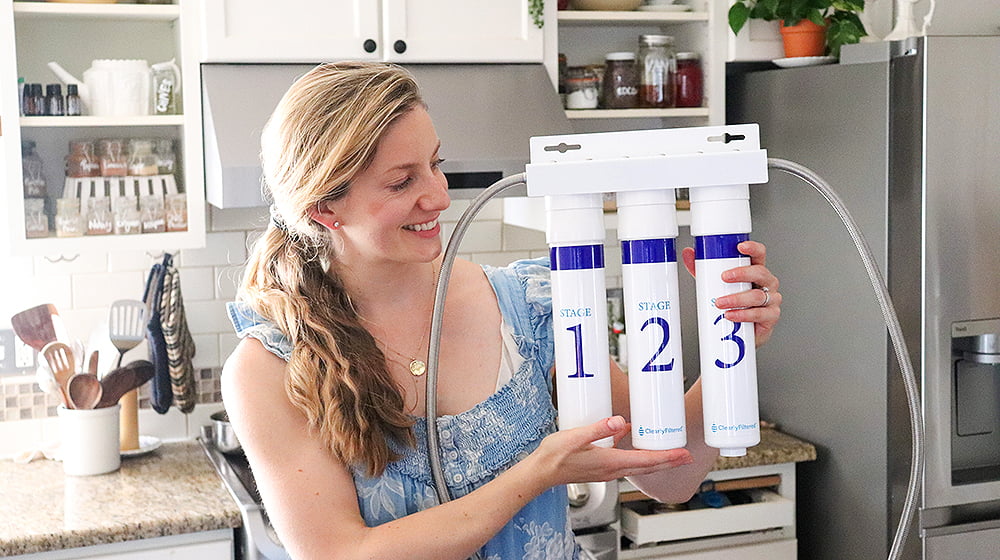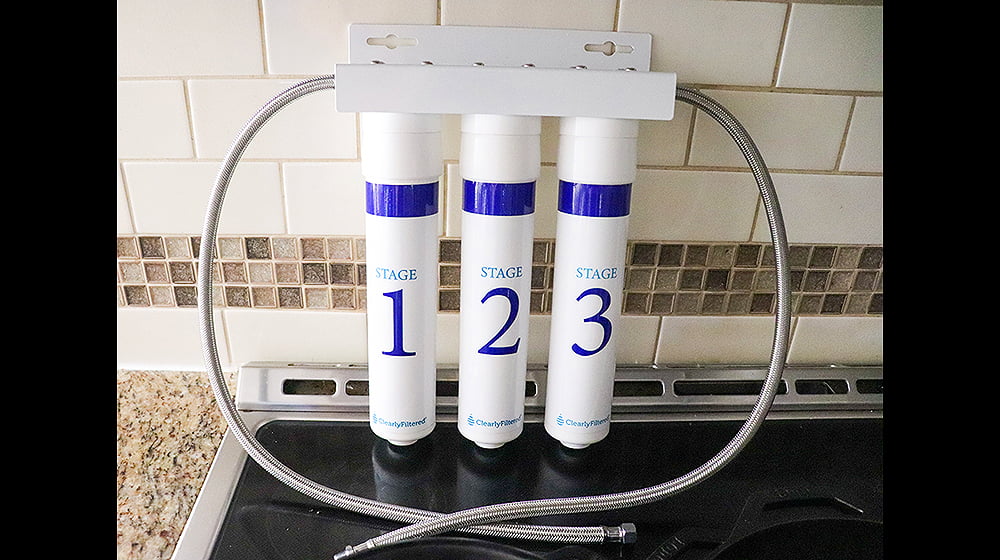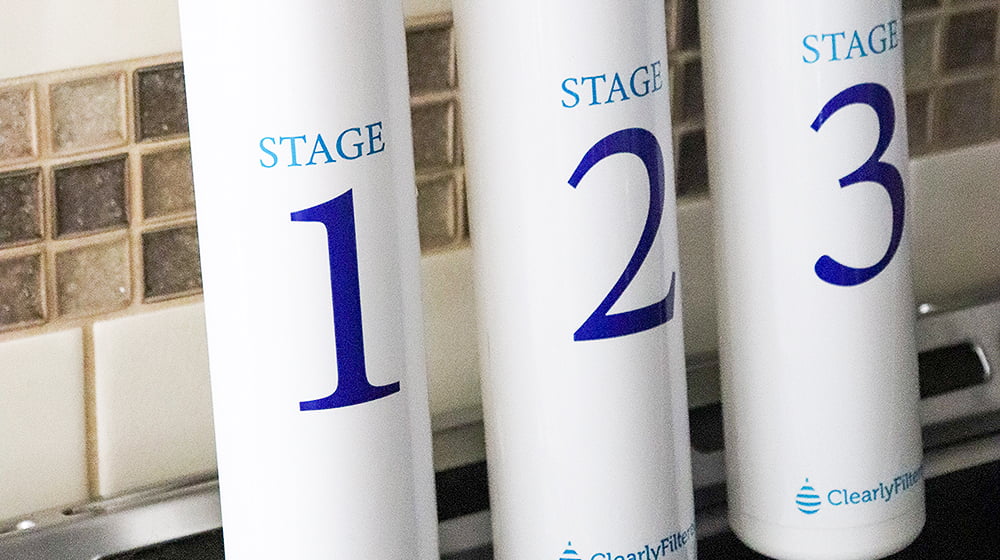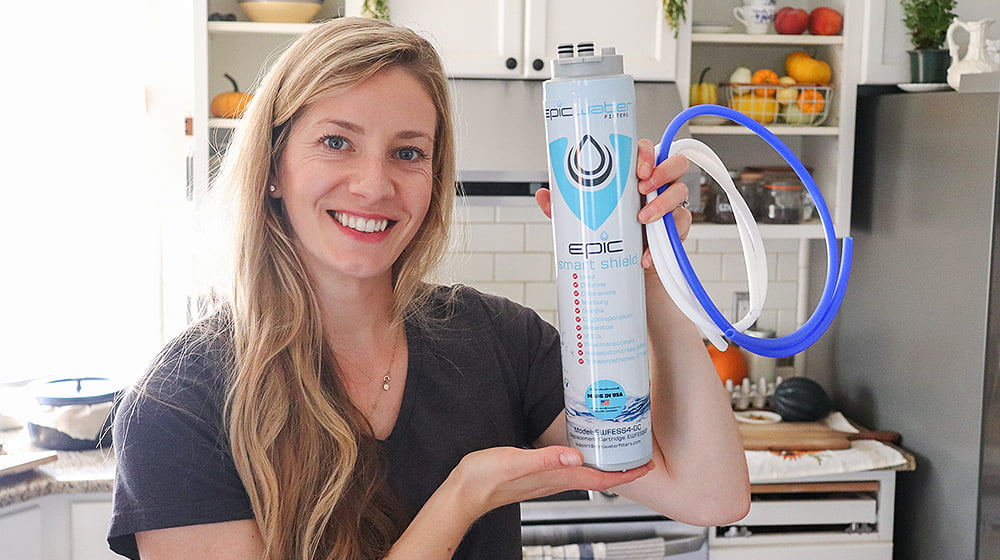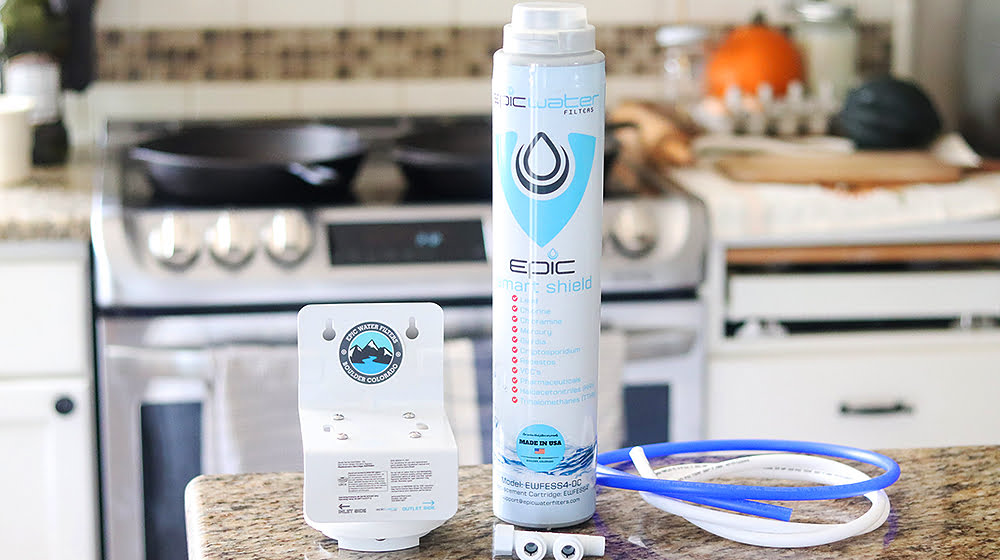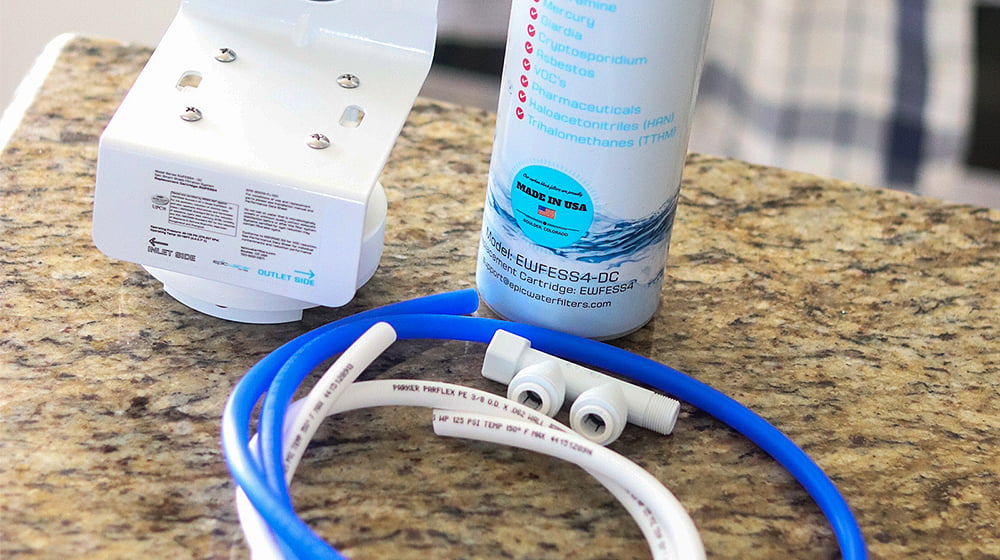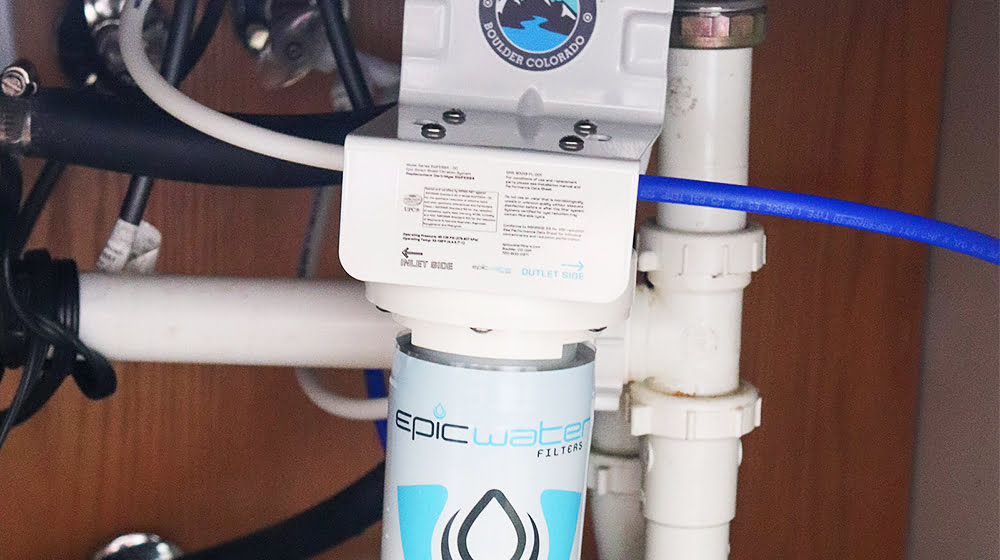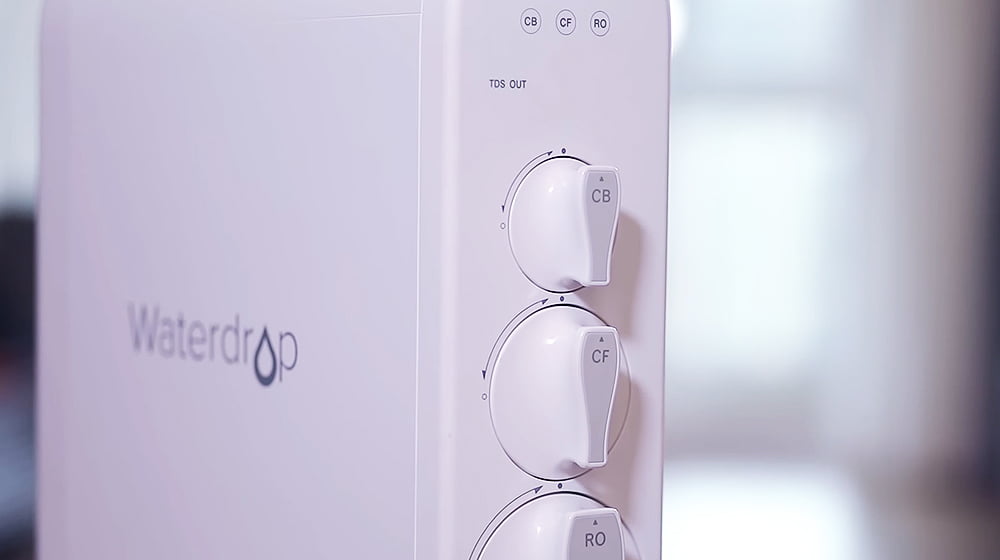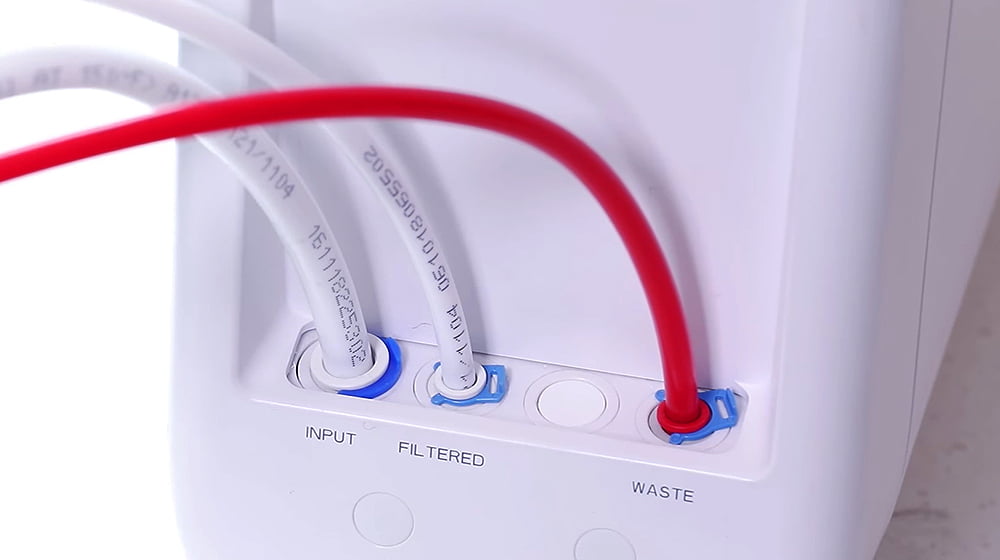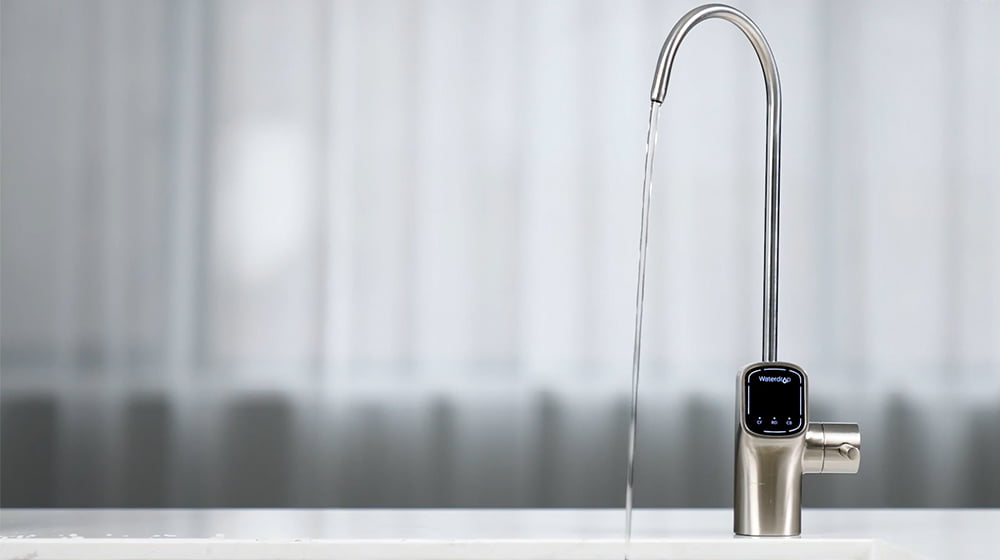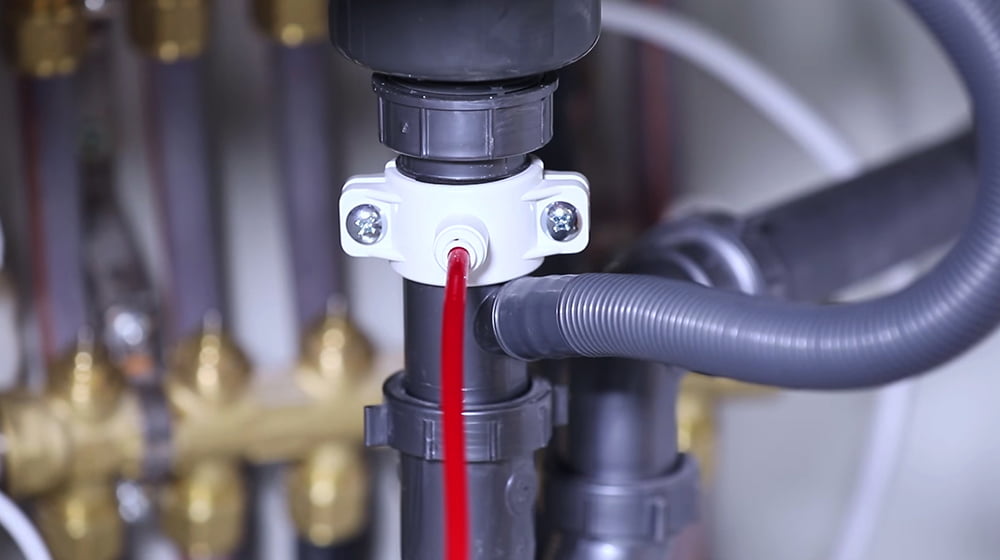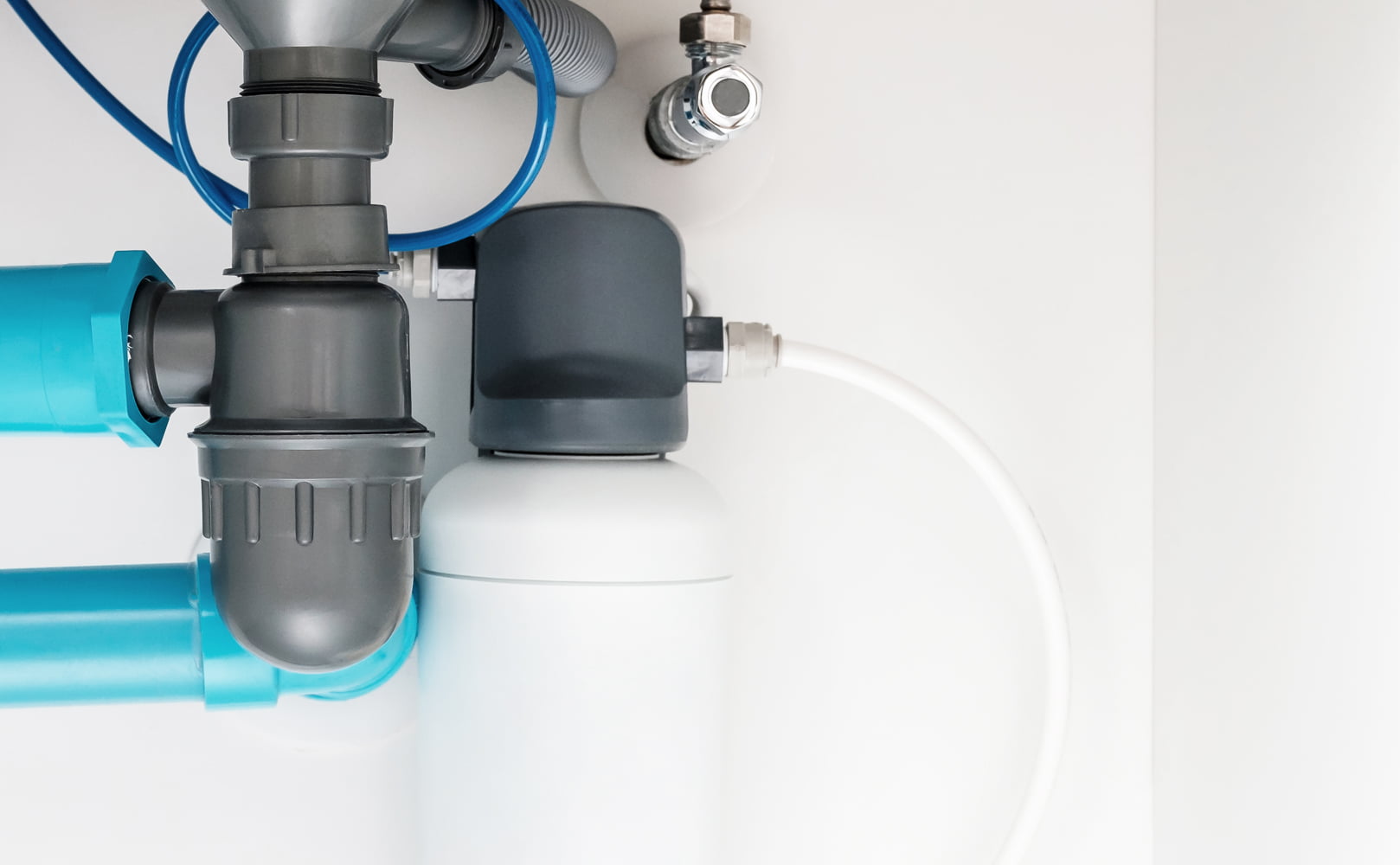4 Best Under Sink Water Filters for Apartments (*Update 2024)
Written by: Gene Fitzgerald // Expert Fact-Checking: Buddhini Dolapihilla, MBSS // Last Updated: Jan 31, 2024
This page may contain affiliate links. If you buy a product or service through such a link we earn a commission at no extra cost to you. Learn more.
Top Pick: What’s the Best Under Sink Water Filters for Apartments?
The best under sink water filter for apartments in 2024 is the Clearly Filtered, because it removes 200+ contaminants (NSF-tested), it is space-saving and the inline design allows for a non-permanent install, it is backed by a 30-day money-back guarantee + lifetime warranty, and it has a long 2,000-gallon filter life.
Finding the perfect under sink water filter for your apartment can be a challenging task, especially with the overwhelming variety of options available. That’s why we have dedicated extensive time and effort to research and review over 28 under sink filters identifying those most suited for apartment use.
Through rigorous evaluation, testing, comparison, and ranking, our comprehensive buying guide provides you with accurate and reliable information. Our aim is to assist you in making the most informed buying decision for your apartment’s water filtration needs.
No Time to Read? Check Our List of the Best Under Sink Water Filters for Apartments!
| Product | Details | |
|---|---|---|
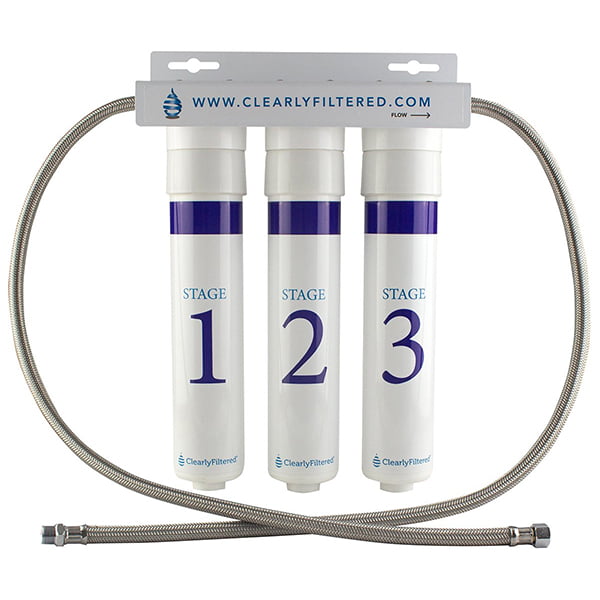 Our Top Pick (Most Effective): Clearly Filtered 3-Stage |
Overall Rating: 5.0/5.0 ⓘRatings based on filtration process, NSF standards, filter life, system size, cost, installation, our own testing, user ratings, product warranty and support, and other factors.
Get 10% Off! Use Code: |
Price: $$$ System Type: 3-Stage, Inline Filter Life: 2,000 Gallons NSF Standards: 42, 53, 401 Annual Cost: $440 Read Review: Click Alexa’s Video Review: Click |
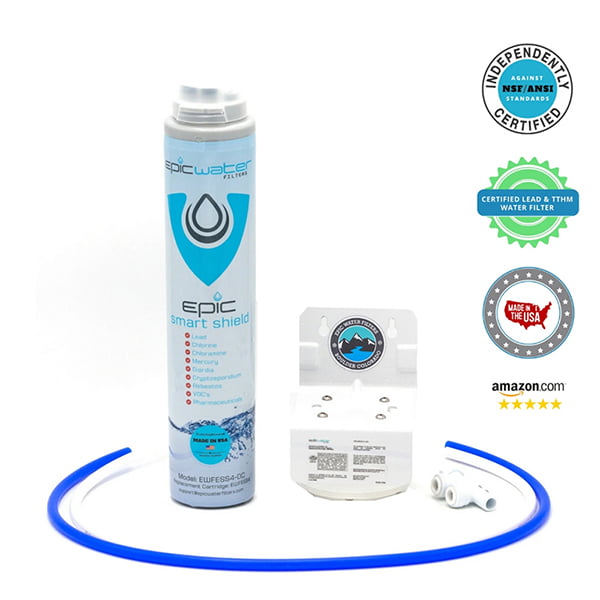 Space-Saving: Epic Smart Shield |
Overall Rating: 4.5/5.0 ⓘRatings based on filtration process, NSF standards, filter life, system size, cost, installation, our own testing, user ratings, product warranty and support, and other factors.
Get 20% Off! Use Code: |
Price: $ System Type: Single Stage, Inline Filter Life: 651 Gallons NSF Standards: 42, 53, 401 Annual Cost: $115 Read Review: Click Alexa’s Video Review: Click |
 Best Using Reverse Osmosis: Waterdrop G3 |
Overall Rating: 4.0/5.0 ⓘRatings based on filtration process, NSF standards, filter life, system size, cost, installation, our own testing, user ratings, product warranty and support, and other factors.
Get 10% Off! Use Code: |
Price: $$$ System Type: Tankless RO Filter Life: 550-2,200 Gallons NSF Standards: 58, 372 Annual Cost: ~$145 Read Review: Click Alexa’s Video Review: Click |
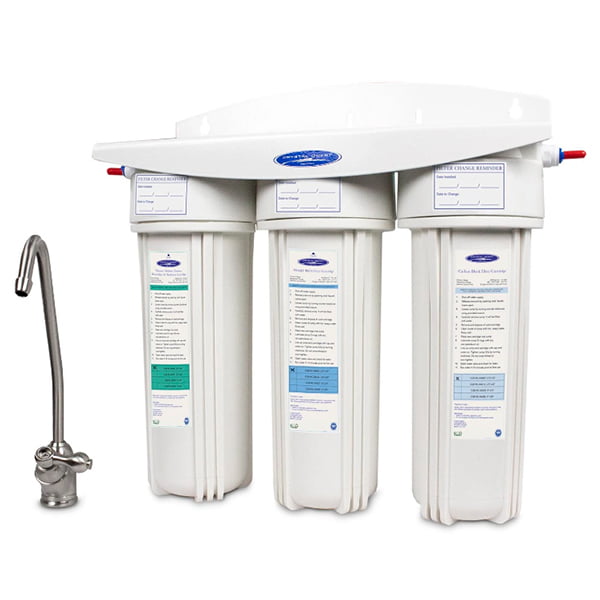 Best for Alkaline Water: Crystal Quest |
Overall Rating: 5.0/5.0 ⓘRatings based on filtration process, NSF standards, filter life, system size, cost, installation, our own testing, user ratings, product warranty and support, and other factors.
Get 5% Off! Use Code: |
Price: $$ System Type: 3-Stage, Alkaline Filter Life: 1-3 Years NSF Standards: – Annual Cost: ~$75-140 Read Review: Click |
Apartment Under Sink Water Filter Reviews
Our Top Picks
- Clearly Filtered 3-Stage – Best Overall (Most Effective)
- Epic Smart Shield – Best for Small Spaces
- Waterdrop G3 – Best for RO
- Crystal Quest – Best for Alkaline Water
1. Best Overall (Most Effective): Clearly Filtered 3-Stage Under-the-Sink Water Filter
In our opinion, the best under sink water filter for apartments in 2024 is the Clearly Filtered 3-Stage. Why? Because it’s very powerful, it features a non-permanent installation, and it’s space-saving. All details below!

Clearly Filtered 3-Stage Under-the-Sink Water Filter |
|
| Price: | $$$ |
| Type: | Inline, 3 Filter Stages |
| Filter Capacity: | 2,000 gal |
| NSF: | 42, 53, 401 |
| Annually: | $440 |
|
Overall Rating: 5.0/5.0 ⓘRatings based on filtration process, NSF standards, filter life, system size, cost, installation, our own testing, user ratings, product warranty and support, and other factors.
Get 10% Off! Use Code: |
|
Alexa’s Video Review
As part of the BOS team, Alexa has installed and tested the Clearly Filtered Under-the-Sink Water Filter System in her own home and with her own hands. She has used the system for several weeks to gather genuine first-hand experience. And most importantly, Alexa has documented the entire process, including her findings and personal opinion, in the video below:
Other Specs
- Model: CF-UTSF
- Last Price: $550.00
- Filter Media/Process: Coconut Carbon Pre-Filter, Proprietary Blends
- WxHxD: 15″x15.4″x3.1″
- Water Temperature: 38-85 °F
- Fitting: 3/8″
- Warranty: Lifetime (Limited)
Key Features & Pros
- Built in the USA.
- The system uses a three-stage filtration process to remove a wide array of contaminants from your home’s water.
- The first stage uses granular activated carbon to remove chlorine, chloramine, foul tastes and odors, turbidity, as well as VOCs, and other organic contaminants.
- The second stage uses a proprietary blend to remove or reduce lead, chromium 6, herbicides, pesticides, PFAS, radiological contaminants, and much more.
- The third and final filter stage is another proprietary blend designed to remove fluoride as well as arsenic.
- The system features a wide array of NSF testing, most importantly standards 53, 42, and 401.
- Tested against over 230 contaminants – making it one of the most thoroughly tested systems available on the market.
- Healthy minerals are retained during the filtration process, and as a result, the filtered water will contain normal levels of essential minerals.
- Inline design easily connects to your existing faucet and water supply.
- High-quality stainless steel inlet and outlet hoses allow for durable and long-lasting operation.
- Installation is fast and easy to complete on your own without any special tools or skills.
- Installation can be completed in just 10 to 15 minutes.
- Inline design and non-permanent design make the system ideal for renters.
- Modular filter cartridges makes them quick and easy to change without needing any tools.
- 2,000-gallon capacity only require replacement once per year.
- Signing up for auto-ship will save you 10% on filter replacement costs.
- 30-day money-back satisfaction guarantee means you can send the system back for a full refund no questions asked.
- Limited lifetime warranty on the system.
Cons
- You can expect a flow rate reduction of 25% to 35% from your faucet.
- USA manufacturing and extensive testing means the price point is higher than many alternative systems.
- Even factoring in the 10% discount for auto-ship, filter replacement costs are fairly high at nearly $400 annually.
Our Rating
- Filtration Performance: 5.0/5.0
- Filter Capacity (Life): 5.0/5.0
- Purchase Price: 4.0/5.0
- Annual Cost: 4.5/5.0
- Overall: 5.0/5.0
Best for
The Clearly Filtered 3-Stage is the best overall option when it comes to an under sink water filter system for apartments.
→ Here’s Our Full Clearly Filtered 3-Stage Review
2. Most Space-Saving Under Sink Water Filter: Epic Smart Shield
Our second most favorite apartment under sink water filter is the Epic Smart Shield. It’s the most compact of all the filters featured in this guide while still being pretty effective.

Epic Smart Shield Under Sink Water Filter |
|
| Price: | $ |
| Type: | Inline, 1 Filter Stage |
| Filter Capacity: | 651 gal |
| NSF: | 42, 53, 401 |
| Annually: | $115 |
|
Overall Rating: 4.5/5.0 ⓘRatings based on filtration process, NSF standards, filter life, system size, cost, installation, our own testing, user ratings, product warranty and support, and other factors.
Get 20% Off! Use Code: |
|
Alexa’s Video Review
Being an integral member of the BOS team, Alexa has ordered and tested the Epic Smart Shield Under Sink Water Filter at home. She shares her hands-on experience of installing and using the system in the video below:
Other Specs
- Model: Epic Smart Shield
- Last Price: $135
- Filter Media/Process: Carbon Block
- Flow Rate: 1.25 gpm
- WxHxD: 4.25″x19.75″x4.5″
- Water Temperature: 33-100 °F
- Water Pressure: 40-120 psi
- Fitting: 3/8″ NPT
- Warranty: Lifetime
Key Features & Pros
- Made in the USA.
- Designed to function both with well and municipal water, however, the manufacturer recommends installing an additional sediment filter stage for systems installed on well water.
- The system will remove over 70 common contaminants including the following:
- Chlorine and chloramine (95.5%), lead (>99.3%), cysts (>99.99%), particulates and turbidity, VOCs (99.6%) mercury (>96.6%), asbestos (>99%), MTBE, BPA, Estrone, Naproxen, Ibuprofen, Phenytoin, Nonyl phenol, E. Coli + Pseudomonoas Aeruginosa, PFOS/PFOA, radiological contaminants, microplastics, and more.
- Features NSF testing and certification for standards 53, 42, and 401.
- Activated carbon coconut block filter material.
- Installation is fast and easy – can be completed in just 20 minutes or less regardless of your level of plumbing or DIY experience.
- The system comes with quick-connect fittings.
- Inline design uses your existing kitchen faucet – eliminating the need for faucet installation.
- A separate polished chrome faucet is available for purchase should you wish to install the system with a dedicated faucet.
- Maintenance requirements are low, only requiring a single filter change every 12 months (or 650 gallons).
- Annual filter replacement costs come to just $115.
- Subscribing to the manufacturer’s ‘Clean Water Club’ will save you 20% on replacement filters.
- Epic’s recycling program allows you to send in three used filters for a free replacement.
- Customer support is responsive and knowledgeable.
- Lifetime warranty on the system plus return policy.
Cons
- The flow rate of 1.25 gallons per minute will likely result in a slight pressure drop from your faucet.
Our Rating
- Filtration Performance: 4.5/5.0
- Filter Capacity (Life): 4.0/5.0
- Purchase Price: 5.0/5.0
- Annual Cost: 5.0/5.0
- Overall: 4.5/5.0
Best for
The Epic Smart Shield system is the ideal choice if you’re looking for a space-saving under sink filter for apartments or condos.
→ Read the Full Epic Smart Shield Review
3. Best for Reverse Osmosis Water Purification: Waterdrop G3 Tankless Under Sink System
In case you are into reverse osmosis water purification, you should go with the Waterdrop G3. It’s a tankless model and thus space-saving and it can handle even the most serious water contamination.

Waterdrop G3 Under Sink Reverse Osmosis System |
|
| Price: | $$$ |
| Type: | Reverse Osmosis, Tankless |
| Filter Capacity: | 550-2,200 gal |
| NSF: | 58, 372 |
| Annually: | ~$145 |
|
Overall Rating: 4.0/5.0 ⓘRatings based on filtration process, NSF standards, filter life, system size, cost, installation, our own testing, user ratings, product warranty and support, and other factors.
Get 10% Off! Use Code: |
|
Alexa’s Video Review
Being part of the BOS team, Alexa has ordered and tested the Waterdrop G3 Reverse Osmosis System, which means she has installed the system with her own hands and used it for several weeks for some genuine first-hand experience! Alexa has documented the entire process, including her findings and personal verdict, in the video provided below:
Other Specs
- Model: G3P600
- Last Price: $539.00
- Filter Media/Process: Sediment, 2x Carbon Block, RO Membrane
- Flow Rate: 0.42 gpm
- Membrane Rating: 600 gpd
- Recovery Rate: 66%
- WxHxD: 5.67″x17.72″x18.12″
- Water Temperature: 41-100 °F
- Water Pressure: 14.5-87 psi
- Warranty: 1 Year
Key Features & Pros
- Four-stage filter system removes a wide array of contaminants from your water.
- Stage 1+2: Composite activated carbon and sediment filter removes organics, chlorine taste and odor, as well as particulates.
- Stage 3: RO membrane removes nearly all contaminants including heavy metals, nitrites/nitrates, and microbial contaminants like bacteria and viruses.
- Stage 4: The final stage is an activated carbon filter block to remove any leftover stuff, foul taste, and ‘polish’ the water’s taste.
- The system is NSF-certified for the removal of TDS (total dissolved solids) and features only BPA-free construction.
- Due to the RO process, installation is a bit more complicated but can still be completed in a few hours.
- The smart screen LED faucet displays the water’s TDS level as well as the remaining filter life.
- A white LED light indicates a healthy filter, a yellow light indicates less than 40 gallons of remaining filter life, while a red light and beeping noise indicate it’s time to change filters.
- A similar display on the system housing indicates the same readings.
- Replacing filter cartridges is very fast and simple due to the tool-free twist design.
- Filter changes take just seconds.
- Annual filter replacement costs come to just $145.
- The flow rate of 0.42 gpm is impressive for a tankless system featuring reverse osmosis.
- Low clean-to-wastewater ratio (1:0.67 gallons).
- Leak protection.
- One-year manufacturer warranty.
- 30-day money-back satisfaction guarantee in case you’re unhappy for any reason.
Cons
- Like other reverse osmosis systems, if the system is left idle for a while, the TDS reading will be high initially. This is known as TDS creep and can be solved by flushing a gallon or until the TDS reading drops to normal levels.
- More specific reduction rates for additional contaminants would be helpful.
Our Rating
- Filtration Performance: 4.0/5.0
- Filter Capacity (Life): 5.0/5.0
- Purchase Price: 3.5/5.0
- Annual Cost: 4.5/5.0
- Overall: 4.0/5.0
Best for
Overall, the Waterdrop G3 tankless RO system is the best option for under sink apartment filtration with reverse osmosis.
→ Here’s the Full Waterdrop G3 Filter Review
4. Best for Alkaline Water: Crystal Quest Alkaline Under Sink Water Filter
Fans of alkaline drinking water will like this one: The Crystal Quest Alkaline Under Sink Water Filter which is another tankless system, but one that uses its own faucet due to a low flow rate.
Other Specs
- Model: CQE-US-00340
- Last Price: $256.80
- Filter Media/Process: 5-Micron Carbon Block, GAC + Catalytic Carbon + KDF + Ion Exchange + Mineral Balls, Mineralization Filter
- Flow Rate: 0.3-0.5 gpm
- WxHxD: 15″x14″x5″
- Water Temperature: 40-90 °F
- Water Pressure: 20-60 psi
- Fitting: 1/4″
- Warranty: 1 Year
Key Features & Pros
- Three stage filter system features a combination of filter media.
- Stage 1: The first stage is a 5-micron carbon block filter to remove particulates like sand, dirt, dust, and sediment. It will also remove chlorine taste and odor, VOCs, herbicides/pesticides, disinfection byproducts, industrial solvents, and more.
- Stage 2: The second stage uses a proprietary design containing both activated and catalytic carbon, two types of KDF filter media, and anion exchange resin. Combined, this filter stage will remove over 99% of chlorine, chloramine, heavy metals including lead, pesticides/herbicides, pharmaceutical by-products, and other inorganic contaminants. Finally, tourmaline and ceramic balls improve the water’s taste and balance the pH.
- Stage 3: The final alkalizing stage contains both calcium and magnesium to mineralize the water and increase pH levels.
- Installation is simple and relatively straightforward.
- Comes with a faucet and all required installation hardware.
- Opt for either flex tubing or copper tubing depending on your existing plumbing setup.
- Maintenance is also simple – all that’s required is occasional filter cartridge replacement.
- Annual filter replacement costs come to just 75$ – $140 annually depending on your usage level and water quality.
- The carbon and alkaline filters will last for between 12 and 18 months, while the proprietary SMART filter will last for up to 3 years of typical use.
- One-year manufacturer warranty.
Cons
- The system doesn’t come with any NSF certifications.
- The flow rate of 0.3 to 0.5 gallons per minute is slow – especially for a non-RO system. This will result in more wait time when dispensing water.
- Installing the system without a licensed plumber will void the warranty. That means no DIY installation if you wish to keep the warranty intact.
Our Rating
- Filtration Performance: 4.5/5.0
- Filter Capacity (Life): 5.0/5.0
- Purchase Price: 5.0/5.0
- Annual Cost: 5.0/5.0
- Overall: 5.0/5.0
Best for
The Crystal Quest is the ideal choice for an under sink apartment filter that can produce alkaline water.
Comparison List
(Mobile Hint: Swipe to Scroll)
| Model | Price | Type | Filtration Process | Water Flow | Filter Capacity | NSF | Annually | Warranty | Additional Info |
|---|---|---|---|---|---|---|---|---|---|
| Clearly Filtered 3-Stage Under-the-Sink Water Filter | $$$ | Inline, 3 Filter Stages | Carbon, Proprietary Blends | Not Specified | 2,000 gal | 42, 53, 401 | $440 | Limited Lifetime | |
| Epic Smart Shield Under Sink Water Filter | $ | Inline, 1 Filter Stage | Carbon Block | 1.25 gpm | 651 gal | 42, 53, 401 | $115 | Lifetime | |
| Waterdrop G3 Under Sink Reverse Osmosis System | $$$ | Reverse Osmosis, Tankless | Sediment, Carbon Block, RO | 0.42 gpm | 550-2,200 gal | 58, 372 | ~$145 | 1 Year | |
| Crystal Quest Alkaline Under Sink Water Filter | $$ | Alkaline, 3 Filter Stages | Activated Carbon, Catalytic Carbon, KDF, Ion Exchange, Mineral Balls, Mineralization Filter | 0.3-0.5 gpm | 1-3 Years | – | ~$75-140 | 1 Year |
Buying Guide: How to Choose the Apartment Under Sink Water Filter That’s Best for You
The following are key features worth considering when shopping for a high-quality apartment water filter to install under your kitchen counter. They will help you choose the right one for your needs and budget.
Permanent vs Non-Permanent Installation
As an apartment dweller, perhaps the most important factor you’ll need to consider is how the water filter will be installed under your sink.
- Inline systems can be installed without any permanent measures, meaning when you remove the filter from under your sink, the cabinet, pipes, and the sink itself will be in the same state as before installation.
- Dedicated faucet systems may require you drilling a permanent hole through the sink or countertop – unless there is a spare hole you can use.
- Reverse osmosis systems not only require their own faucet, they also need a drain saddle which requires you to drill through your drain pipe.
Now, drilling may be prohibited and could cause issues with your landlord. So when in doubt it’s best to consult your landlord or building manager directly.
In summary, inline systems are the perfect solution for renters, as they connect directly to your sink’s cold water supply as well as to your existing faucet. They are also typically very simple to install and remove, taking less than 20 minutes in most cases. Dedicated faucet and RO systems are best for apartment owners.
Filter Size
As apartments and condos typically have limited cabinet space, the filter system’s size will be an important consideration. If your kitchen sink cabinet is on the smaller side, then once again inline systems might be your best option, as they don’t require storage tanks and as a result tend to be compact.
The Quality of Your Apartment Water
When it comes to picking out any water filter system, whether in an apartment or house, one of the most important considerations is your water quality. Your water quality refers to the specific contaminants it contains as well as the quantities of said contaminants.
For well supplied water the best way to determine your water quality is to test your water using either a home test kit or by having it professionally tested. Home test kits are cheaper and offer instant results, but are less accurate than professional water testing. Professional testing will cost more – typically several hundred dollars – but is the best way to determine the exact contaminants in your water and their quantities.
For municipal water – which will be the case for most apartment dwellers – you can also consult several publicly available resources like the EPA’s safewater or EWG’s Tap Water Database which will give you the most recent public water testing results in your area. Keep in mind that these resources can miss contaminants specific to your building’s plumbing like lead which may be present in buildings with older pipes.
Getting an NSF-Tested or Certified Product
NSF testing and certification is the most surefire method of confirming the filtration claims made by the manufacturer. The NSF is an independent organization that conducts third-party testing on water filter systems and other household appliances. Other organizations that perform NSF standardized testing include the IAPMO and WQA.
When it comes to under sink systems for apartments, there are a few key certifications to look out for:
- NSF Standard 42: This standard pertains to the removal of ‘aesthetic effects’ from your water. This includes chlorine/chloramine, foul taste and odor, as well as particulates.
- NSF Standard 53: This standard relates to the removal of contaminants with known ‘health effects’ from your water. It includes contaminants like mercury, lead, VOCs, cysts, radon, and asbestos.
- NSF Standard 401: This standard refers to the removal of ‘emerging compounds’ from water. This refers to contaminants with suspected negative health effects such as BPA, estrone, naproxen, DEET, and metolachlor.
- NSF Standard 58: This standard is specific to reverse osmosis systems and tests for the reduction of total dissolved solids (TDS) among many other analytes.
The Filtration Technology Used
Under sink water filter systems can feature a variety of different filtration technologies, which is why testing your water for contaminants is so important. This allows you to tailor your system selection to deal with the specific contaminants in your apartment’s water.
- Sediment filtration is the simplest and cheapest filter technology available. This filter type uses a fine mesh to remove particulates like sand, silt, rust, and sediment from your water. Sediment filters are typically used in conjunction with carbon and reverse osmosis systems, as sediment removal is important to prevent clogging of later filter stages.
- Carbon filtration is another common filter type and uses either granulated carbon or a carbon block to remove chlorine/chloramine, poor tastes and odor, pesticides/herbicides, and other organic contaminants using a process known as adsorption. There’s also a difference between activated and catalytic carbon with the latter being more powerful.
- KDF media is used to remove heavy metals like lead, iron, chromium, and mercury, as well as hydrogen sulfide and calcium carbonate. It’s also useful for preventing the growth of bacteria, fungi, and algae within the filter system. It’s often used in systems designed for well water, as it targets many of the contaminants commonly present in these systems.
- Reverse osmosis is a highly effective filter type capable of removing a wide array of contaminants and impurities including heavy metals, organic and non-organic contaminants, and microbes. Reverse osmosis systems require a dedicated faucet as well as a drain line connection, meaning installation of these systems can be tricky for apartment dwellers.
# of Filter Stages
Generally speaking, the more filter stages a system has, the more effective it will be at removing contaminants. On the other hand, systems with multiple stages tend to cost more and will require more maintenance in terms of filter replacements.
Output Water Flow/Pressure
Another important consideration – especially when it comes to inline filters – is the flow rate or water pressure at the faucet. Flow rate refers to the speed at which a system can filter water – and is measured in gallons per minute (gpm).
The reason this measurement is so important when it comes to inline under sink water filters is that all of the cold water coming out of your kitchen faucet will need to pass through the filter. Too low of a rate and you’ll be constantly waiting to fill glasses, pots, and water bottles.
The flow rate of a normal kitchen faucet without any filter installed is generally around 2 gpm (gallons per minute). Between 1 and 2 gpm, you’re unlikely to notice much reduction in water pressure, and below 1 gpm the water pressure reduction becomes very noticeable.
Reverse osmosis systems have the lowest flow rates out of any filter type due to the RO membrane design. To solve this issue, these systems typically feature storage tanks to keep filtered water on hand as well as separate faucets so the low pressure only affects the RO faucet.
Maintenance and Filter Life
When it comes to maintenance, most systems are very easy to handle, with most only requiring occasional filter changes. This can often be done without the need for any tools by twisting, removing, and replacing the old cartridge.
Filter life refers to the total number of water gallons a cartridge can filter before needing replacement. Manufacturers will typically provide the filter life both in gallons as well as the number of months before replacement. Keep in mind these figures are calculated under ideal conditions and as a result real-life performance tends to fall short.
Costs
Naturally, any time you’re considering spending a significant amount of money on a product, cost will be a factor.
Luckily, under sink water filters for apartments tend to fall on the cheaper side. The systems reviewed above range from just over $100 to $500+, so there are plenty of options for every price range.
When considering a filter system, it’s important to factor in the annual maintenance (filter replacement) cost as well. This will allow you to calculate the cost of the system over time, as some cheaper filters will cost more in the long run.
More on Under Sink Water Filters for Apartments
What Is an Apartment Under Sink Water Filter and How Does It Work?
An apartment under sink water filter is any filter system designed to fit in an apartment’s under sink cabinet. Of course, an apartment system can vary somewhat, and not all of the above systems will work for every apartment.
Apartment systems can either be permanent or non-permanent, with non-permanent systems not requiring any permanent alterations to your plumbing or countertop when installing. For most apartment dwellers, non-permanent systems will be the preferred option as these avoid any issues with “damaging” the residence.
The Different Filter Types
Let’s take a brief look at the most common under sink apartment filter systems and how they work.
Single-Stage and Multi-Stage Under Sink Water Filters
Filter systems can either feature a single-stage filter cartridge or multiple stages.
Single-stage systems, as you might expect, tend to be less expensive, easier to maintain, but also remove fewer contaminants from your water. They also tend to be more compact and as a result a good option for apartments with smaller sink cabinets.
Multiple-stage systems offer more through filtration, with the various stages typically featuring different filter media. They also tend to cost more, require more maintenance along with higher associated maintenance costs, and tend to take up more real estate inside a kitchen cabinet.
Reverse Osmosis System
Reverse osmosis systems are a specialized type of filter that uses an ultra-fine RO membrane to separate and remove contaminants via wastewater. These systems require the installation of a separate RO faucet, as well as a drain pipe connection, both of which require drilling permanent holes.
Inline vs. Dedicated Faucets
Inline under sink water filters are systems that are installed ‘inline’ with your existing under sink plumbing. This means they connect to your existing cold water supply as well as your existing kitchen faucet. These systems are the ideal option for many apartment dwellers as installation is non-permanent, and they can be installed and removed without leaving a trace.
Systems with dedicated faucets require a secondary faucet on your countertop to dispense filtered water. This typically requires drilling a hole through the sink or countertop, although sometimes this can be avoided by repurposing an existing hole for a soap dispenser or water jet.
Is Apartment Water Safe to Drink? Who Should Use a Filter?
Whether or not apartment water is safe to drink will vary widely depending on your water source.
By EPA standards, the vast majority of municipal water is safe to drink as it undergoes thorough treatment for things like microbial contaminants. Safe by EPA standards does not mean free from contamination, though. Your tap water could meet maximum allowable contaminant levels and still contain heavy metals such as lead or certain pesticides etc. Also, as a result of water disinfection, your water may contain disinfection byproducts some of which are associated with cancer. And the disinfectants themselves, think chlorine or chloramine, can impart a foul taste and odor.
If your water is sourced from a well – which is less common for apartment buildings – it’s more likely to contain elevated levels of contaminants like hydrogen sulfide, nitrites, iron, bacteria, or overall TDS.
Bad Taste and Smell
The usual culprit behind bad taste and smell in drinking water is chlorine from municipal water treatment. This can be removed in most cases using a simple carbon filter.
Harmful Substances
Let’s take a look at some of the most common harmful water contaminants you’re likely to face.
Lead
The presence of lead in drinking water is a serious cause for concern. Lead is a powerful neurotoxin that hinders proper intellectual development in children and permanently changes behavior.
When it comes to drinking water, the primary source of lead contamination is older plumbing lines with either lead pipe or lead-based plumbing solder. As lead levels vary widely from one home to another, it’s hard to estimate the exact number of people dealing with lead contamination in their water supply.
Lead can be removed using reverse osmosis, distillation, ion exchange, as well as activated carbon filters.
Disinfection Byproducts
Disinfection byproducts are cancer-causing byproducts created by the reaction between chlorine and other disinfectants with organic waste. These contaminants have been shown to increase cancer risk as well as harm developing fetuses.
As disinfecting drinking water to remove harmful microbial contaminants is necessary, it’s difficult to remove all disinfection byproducts from water.
The two most prominent disinfection byproducts in public water supplies are trihalomethanes (THMs) and haloacetic acids (HAAs).
Disinfection byproducts can be best removed using activated carbon filtration.
VOCs
Volatile organic compounds (VOCs) are a group of solvents that increase the risk of cancer, harm the nervous system, as well as impede fetal and childhood development. These chemicals originate from a variety of substances including paints, solvents, gasoline, carpets, and vehicles.
As these substances are widespread it’s difficult to estimate the number of people at risk. The federal government set limits on 21 VOCs between 1987 and 1992, but unfortunately, no new limits have been set since despite increasing evidence of the harmful nature of these chemicals.
VOCs can be removed through activated carbon as well as water distillation.
Arsenic
Arsenic is a naturally occurring heavy metal that irritates the lungs and bladder, as well as causing skin cancer. It may also cause kidney, liver, and prostate cancers.
Arsenic is fairly common in drinking water throughout all 50 states and typically finds its way into water supplies by leaching from rocks into groundwater. It’s found in both municipal and well supplied water.
Simple carbon filtration is not sufficient to remove arsenic from drinking water. Either reverse osmosis or ion exchange are needed to remove this stubborn contaminant.
Using an Apartment Under Sink Water Filter As a Renter
As this article is directed at apartment dwellers looking for an appropriate under sink filter, it makes sense to address some of the issues that might pop up in this situation.
Am I Even Allowed to Use a Water Filter?
When it comes to installing an under sink water filter in an apartment, the first question that arises is whether you can install one at all.
If you’re talking about a system with a dedicated faucet or an RO system requiring permanent drilling through the countertop and sink drain pipe, then likely you’ll need to ask your landlord or building manager for permission.
On the other hand, inline systems do not require any drilling, and won’t alter or damage any existing materials. Whether or not this is permitted will depend on your particular building, but realistically there is no way to tell if an inline system was installed after removing it.
Is the Installation Permanent?
As mentioned previously, under sink systems can either require permanent installation (as is the case for RO systems and dedicated faucet systems) or temporary installation (as is the case for inline systems).
It’s also worth mentioning that some dedicated faucet systems can be installed using an existing hole for a soap dispenser or water jet. RO systems require a drain line connection, which means drilling into your drain pipe, so they generally can’t be installed in a non-permanent fashion.
How Complicated Is the Setup?
Inline systems are the easiest type to install, as they use your existing cold water supply and faucet. As a result, these systems can typically be installed in 20 minutes or less.
Reverse osmosis and dedicated faucet systems require a more complex installation, and typically take an hour or two to complete.
Is Drilling Involved?
Drilling is only typically required for reverse osmosis systems and systems with dedicated faucets. Inline systems do not require any drilling whatsoever.
Are Apartment Under Sink Water Filters Expensive?
Under-the-sink filter systems for apartments are generally affordable, and taking the above models as an example, retail for between $100 to $500.
Do I Have to Leave My Water Filter Behind If I Move?
The answer to this question will depend on any arrangement you reach with your landlord, but generally speaking no, you don’t need to leave behind your water filter when you move. This is especially true for inline systems that don’t require permanent installation.
Frequently Asked Questions (FAQ)
- What other types of water filters are suited for apartment use?
Best suited are water filters that are either installation-free or don’t involve an intrusive setup, including water filter pitchers, countertop water filters, and faucet water filters. - Are there any specific maintenance requirements for under sink water filters in apartments?
No, there are not. You maintain them in exactly the same way you would maintain any other under sink water filter. - Are apartment under sink water filters compatible with different types of apartment faucets?
Most faucets use the same sized fittings and tubing, so there shouldn’t be an issue. - How much space is required under the sink for installing an under sink water filter in an apartment?
This depends on the type and size of filter used. For example, the Epic Smart Shield which is a single-stage under sink water filter measures 4.25″x19.75″x4.5″. In comparison, the Waterdrop G3 RO system uses 5.67″x17.72″x18.12″. A tank-based reverse osmosis system would require even more space. - Are apartment under sink water filters designed to handle the water pressure commonly found in apartments?
The ideal water pressure is 60 psi and it’s found in most homes regardless of apartment style vs single-family home.
How We Chose and Tested the Best Apartment Under Sink Water Filters (Why Trust Us)
- Establishing Criteria: The first step was to develop a list of 18 key attributes to evaluate all under sink water filters against and identify those best suited for apartment use.
- Initial Selection: We already had compiled a comprehensive list of both well-known and newly released under sink filters, resulting in over 28 options to consider.
- Thorough Evaluation: To narrow down our selection, we conducted a thorough evaluation process. This involved examining product manuals, descriptions, warranties, and third-party certifications/test data based on industry standards set by organizations like the NSF, EPA, and CSA. Additionally, we also drew on our past experiences with many of the brands such as Clearly Filtered, Epic, and Waterdrop. Basically, we wanted to assess their support level and expertise.
- User Feedback Analysis: We then extensively analyzed user feedback and third-party ratings from various platforms. We took great care to filter out any fake or unreliable reviews. At this point we had 4 products remaining.
- Hands-On Testing: To gain firsthand experience with the selected under sink water filters, we purchased and installed 3 of them onto a suitable water supply. Each system underwent a strict review process from every possible angle, including considerations like size, ease of installation, maintenance, and the quality of the filtered water in terms of pressure and taste. We ensured that each filter operated for a minimum of 3 weeks to gather sufficient data.
- Lab Testing: In order to validate our findings, we conducted independent lab testing using reputable services like Tap Score/ETR Laboratories. This allowed us to assess the real-life reduction rates of contaminants.
- Finally, we analyzed all the gathered information, converted it into easily understandable insights, and presented everything in a pros and cons format.
Please note that our reviews are impartial and unbiased. Also, all the information and ratings provided have undergone professional fact-checking to ensure accuracy. For one, Buddhini Dolapihilla, MBSS, evaluated contamination reduction claims, particularly in relation to NSF certifications.
About Our Ratings
Our rating system for apartment under sink water filters takes into account the following key factors:
- Contaminant reduction rates based on NSF testing (30%)
- Price and annual cost (25%)
- First-hand testing and user opinions (20%)
- Filter life (15%)
- Customer service and product warranty (10%)
Each system is rated on a scale of 1 to 5, with 5 being the highest rating.
Questions? Ask away!
Information provided on BOS is for educational purposes only. The products and services we review may not be right for your individual circumstances.
We adhere to strict editorial guidelines. Rest assured, the opinions expressed have not been provided, reviewed, or otherwise endorsed by our partners – they are unbiased, independent, and the author’s alone. Our licensed experts fact-check all content for accuracy. It is accurate as of the date posted and to the best of our knowledge.

